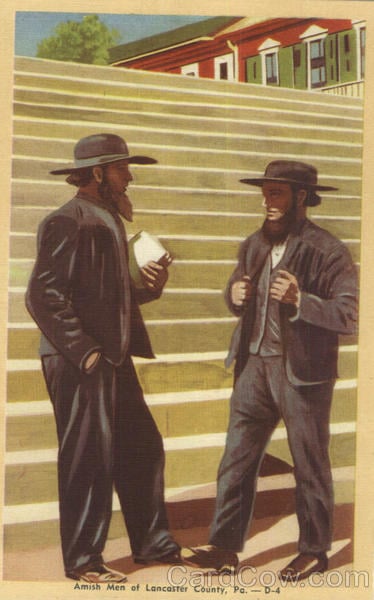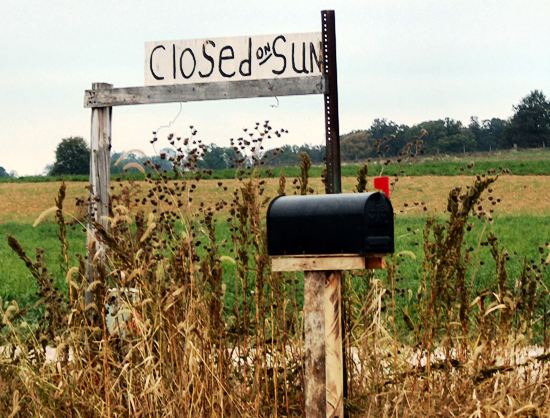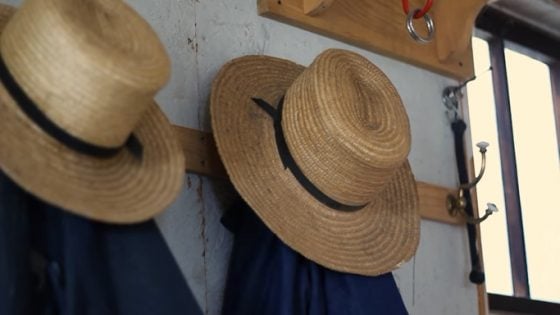Ammon Aurand’s “Little Known Facts about the Amish and the Mennonites”
Any work that discusses bundling in ‘the good old-fashioned way’ has got to be a heady read.
And so it goes with Little Known Facts About the Amish and the Mennonites, a tourist booklet first printed in 1938.
The seeds of Amish tourism were planted in the early 20th century, with the enterprise really getting a proper start in the 1930’s and 40’s. Amish-themed postcards, novels, and magazine articles all helped to spur along what has become a full-fledged industry today.
Early Amish tourism depended on a body of knowledge that mixed fact and falsehood. With the goal of enticing visitors to Amish-inhabited areas, particularly Lancaster County, writers perpetuated a number of myths such as the ‘blue gate’ legend while describing other aspects of Amish and Pennsylvania German life more or less accurately .
Ammon Monroe Aurand Jr.’s 1938 pamphlet Little Known Facts about the Amish and the Mennonites was among the first of a pile of literature on the Amish that helped fuel the boom.
Aurand himself was a Harrisburg bookstore owner who produced a large body of spiced-up folklore on Amish and Pennsylvania German life during the 30’s and 40’s.
Looking at Little Known Facts today, one finds a number of quite amusing ‘facts’ as well as a quaint, playful style of writing that can be downright entertaining. Which I suppose is more the point–entertainment–when cranking up a fledgling tourist industry, than necessarily nailing down a sense of sociological or historical accuracy. Visitors came for amusement, and Aurand provided it with his pamphlet.
A sampler of “Little Known Facts”
Throughout the booklet Aurand enlightens readers with a cornucopia of quirky, homespun views on the Amish and Mennonites, sharing matter-of-fact insights such as:
Jews, Catholics and the plain people alike prefer not to let any other faith get a hold on their off-spring until after they have lived through formative years.
and:
These people take their time with nearly all things–they rarely show impatience, except that they are impatient to be always at work–at doing something. They know that life may reproduce itself in nine months, and that time goes on. Their place and mission on earth is a preparatory one, and they must be “about the Father’s business,” whatever it be, to be in a happy mood.
He also makes a few observations on appearance and clothing:
The men’s hats are a distinctive, broad, stiff-brimmed type–one looking just like another–dust and all!
It is the usual thing for Old Order Amish boys to wear their hats nearly all of the time, except while in school. At recess they cannot be persuaded to doff them while at play.
Aurand on buttons–I have to admit I’d never heard this reasoning before:
If one could get into a friendly and understanding discourse with men of this faith, as has been done occasionally, one would learn that buttons on the backs of coats, or on coat sleeves, were actually places for the “devil to hang ‘somesing’ on.” Buttons are made from the bones of animals, and this is one reason for their declining to use them.
On the Amish and hair:
There is only one style of wearing the hair among the Amish women,and that bears very little improvement. It is parted exactly in the middle and combed smoothly down toward the temples, where two plaits are started, carried around and gathered into a knot just under the edge of the white mull cap above the nape of the neck.
One or two Amish countrymen, when seen in Lewistown, Lancaster or Ephrata, create little excitement, but when fifty or a hundred get together in a world outside their own, that’s news.
On Big Valley and Little Children
Aurand looks outside of Lancaster County to describe the Amish of Kishacoquillas (“Big”) Valley, making a point along the way on the oral nature of the Ordnung:
The Amish of the Mifflin County Area are severely plain in”back-sections;” often without any modern conveniences; no blinds at windows or doors; no rugs; simple wearing apparel, home-made, or perhaps ordered through a specialist in the making thereof.
An informant says that these people have no pictures on the walls–only mottoes and gaudy calendars.
A woman of mature years, having a new home erected, on entering it one day discovered modern plumbing devices had been installed, and she forthwith ordered removal of same.
They eat enough, and of good variety, and their complexions appear quite superior to the “healthy appearances” obtained from boxes and jars which may be purchased in drug stores.
Church rules are not a matter of printed or written record, but of oral delivery or tradition among the Old Amish. It is not impossible that this condition may lead to unpleasant and unlooked-for results some day, if perhaps such has not been the case in more instances than have generally come to light.
Aurand also perhaps reveals more about his own pretensions (or those of the time) than of the Amish themselves in a number of passages, notably:
Children Sometimes Backward.–Conditions among these people sometimes really require sympathy, especially among the young who sometimes hide themselves from the sight of “English” persons, making use of corn-shocks, or whatever they find handy.
This practice is not unusual among children of some other persuasions, where the parents have too much stunted their natural mental developments; but then, too, we do know it to be a too-common-practice of our “English” people to ridicule people of other origins.
Aurand goes on to detail farming practices, church services, and of course, bundling. In sum, though written perhaps more to stimulate than educate, Little Known Facts is interesting in that it reveals the burgeoning fascination of the time for these ‘peculiar people’. It also had the effect of galvanizing interest among the public for the Amish and Mennonites, and ultimately did its part to help lay the tracks for today’s thriving Amish-themed tourist industry.
Further Reading: See David Weaver-Zercher‘s The Amish in the American Imagination.








Read this article about the Amish today and thought you might find it interesting…
foxnews.com/story/0,2933,465868,00.html
I live in rural southern Indiana and the Amish are a staple here – I enjoy reading your blog and learning about their ways and lifestyles – nice to know more about these quiet, humble people.
Thanks for passing on the heart/gene article-interesting-and I do appreciate the kind comments!
Getting to know the Amish better
Having lived and worked in Indiana for a few years, I had on many occasions contact with the Amish famlies. In a way, I envy their life style. Hard workers, an Honest people, who do not accept free things, unless it can be made in a trade nor do they expect their 5 minutes of fame or fortune and will bend over backwords to help others in need. The only way to really get to know the Amish and their customs is to live amongst them for a while or have everyday dealings.